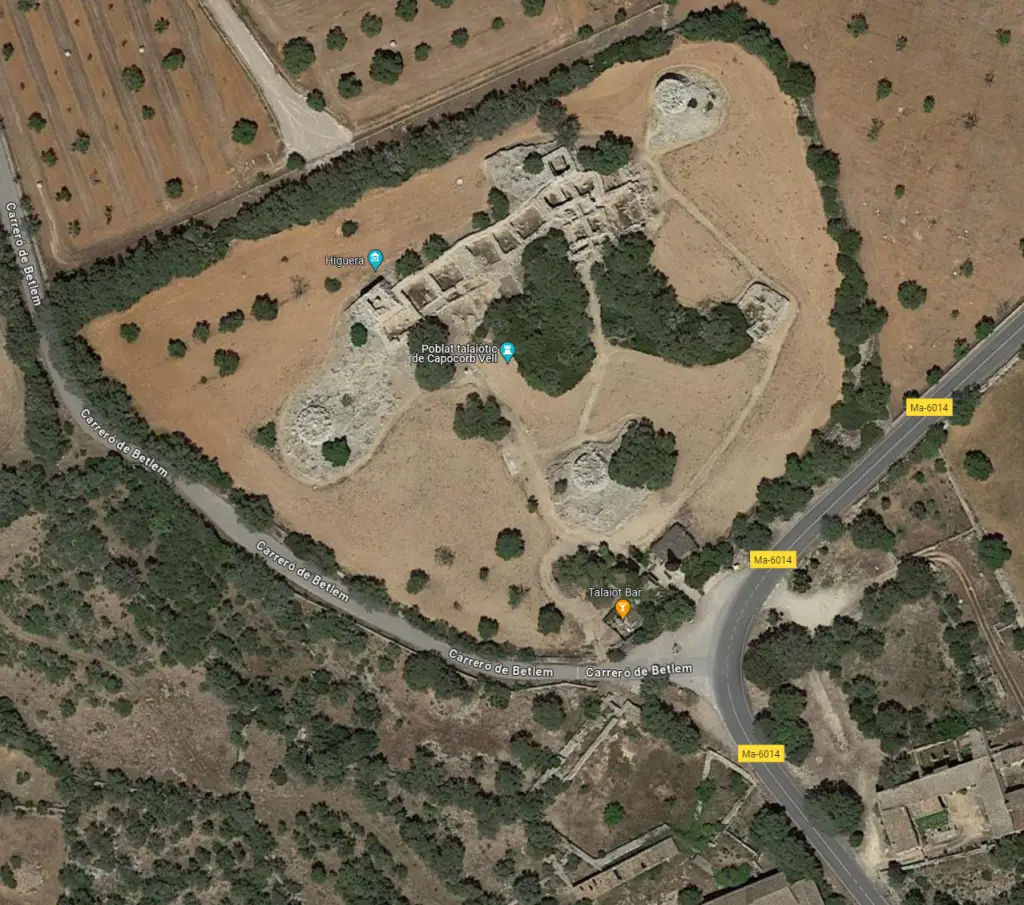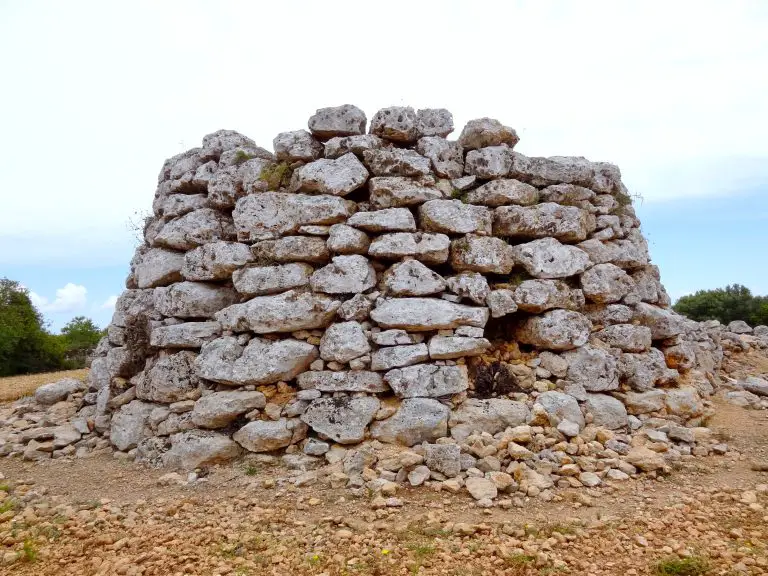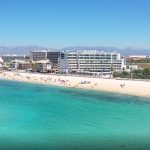Table of Contents
In the fields not far from the coast in the southeast of Mallorca lies Capocorb Vell. A remarkable archaeological site offering an alluring glimpse into the island’s ancient history.
Capocorb Vell is one of the best-preserved settlements in the Balearics from the Talaiotic culture that dominated the islands during the Bronze Age.
This is an impressive site featuring several mysterious circular stone towers along with the ruins of an extensive village that dates back over 2,500 years. For history and archaeology enthusiasts visiting Mallorca, Capocorb Vell should be high on the list of must-see attractions.
While the site is somewhat off the beaten track and less visited compared to other famous island landmarks, a trip here rewards the intrepid explorer with an up-close look at some astounding ancient architecture.
Wandering amidst the atmospheric ruins gives one the eerie sense of stepping back in time into Mallorca’s mysterious past.
A Unique Glimpse into a Vanished Culture

Mallorca’s Talaiotic culture flourished on the island from around 1300 BC to 500 BC during the Late Bronze Age and Early Iron Age periods. It takes its name from the talaiots – striking circular stone towers that dot the Mallorcan landscape from this era.
These imposing structures were built without the use of mortar or cement by a civilization that left behind no written records. Capocorb Vell is exceptional as one of the largest and most thoroughly excavated Talaiotic settlements, providing rare insights into the daily life and beliefs of this prehistoric society.
The site spans over 6000 square meters, encompassing five complete talaiots – three round and two square in shape – along with extensive remains of a walled village.
Archaeologists have identified the ruins of 28 dwellings at Capocorb Vell so far, but it is believed that the settlement once stretched much further northeast. The dwellings are fairly uniform in design, consisting largely of square rooms that may have had adjoining antechambers.
The inhabitants likely kept livestock and stored grain inside their homes. Groupings of these homes were clustered together inside the protective outer walls of the village.
The circular talaiots at Capocorb Vell could have served many purposes, including as defensive watchtowers, burial complexes, granaries, community spaces for storage or rituals, or elite residences and status symbols.
Some archaeologists even theorise that the entire site may have functioned primarily as a ceremonial centre instead of a permanent settlement.
The nearby Capocorb Vell house, currently a private farm estate, could mark the location of the actual village where most inhabitants lived.
In any case, these megalithic tower structures undoubtedly played an important communal role in the Talaiotic culture, representing major feats of architectural engineering.
Well Preserved Ruins from Multiple Eras
Thanks to the arid climate and lack of development in the area, the ruins at Capocorb Vell remain remarkably intact.
The settlement shows signs of occupation spanning several distinct periods in history before the site was ultimately abandoned during the early Middle Ages.
This long period of continuous use makes Capocorb Vell somewhat atypical among ancient Talaiotic sites across Mallorca, where later inhabitants often dismantled abandoned ruins for building materials.
The earliest artefacts found here, including pottery fragments, date to the 6th century BC during the Talaiotic era when the stone structures were initially built and the village was established.
Repairs and additions to the buildings indicate that life continued here during the Post-Talaiotic period (550 BCE – 123 BC). Under Roman rule, the site remained occupied as a rural estate from 123 BC – 425 AD, followed by an Early Christian presence from 425 – 550 AD.
Archaeologists have also found Islamic-era artefacts, suggesting some human activity during the early Middle Ages period up until the site was permanently abandoned in the 10th or 11th century.
This unusually long timeline for a single archaeological site provides researchers with insight into how daily existence and settlement patterns evolved over the centuries for rural inhabitants on Mallorca.
It also means visitors can view architectural details and artefacts representing multiple distinct eras spanning more than 1500 years – quite extraordinary for what now appears as ruins in a quiet field.
Early Excavations Reveal Hidden Secrets
While early antiquarians and historians made note of the visible remains at Capocorb Vell throughout the late 19th and early 20th century, systematic excavation of the site did not begin in earnest until 1918.
Under renowned Spanish archaeologist Josep Colominas Roca, the first scientific dig unearthed a sizable necropolis area housing 25 tombs clustered along the southeast exterior of the ancient village. Later work by other teams has since uncovered additional burials across 50 identified grave sites.
Analysis of the skeletal remains and items interred alongside the buried bodies suggest that Capocorb Vell inhabitants utilised two separate necropolis zones – one reserved primarily for adults and another for cremated children.
A study of these Early Talaiotic-era tombs and their grave goods paints a picture of how early island settlers conducted burials and possibly venerated their deceased community members.
Beyond this necropolis area, archaeologists focused most subsequent excavation initiatives on clearing rubble and soil deposits to expose the foundations of the settlement’s various stone buildings.
Years of painstaking digging and surveying have gradually revealed the ground plans for dwellings of various shapes and sizes along with more clues about how villagers engineered the cyclopean blocks to erect the talaiots and perimeter walls.
Ongoing research aims to solve lingering mysteries about the site’s precise occupation timeline, how the design and uses for structures changed over the centuries, and what everyday life looked like during its lengthy period of habitation.
Paying a Visit to Step Back in Time
Part of the site’s undeniable magic stems from its location amidst quiet farmland dotted with almond, carob and olive trees, creating an oasis of solitude and tranquillity perfect for peaceful contemplation about the past.
From the elevated central viewpoint near the tallest talaiot, you gain a feel for how this stronghold would have dominated the agricultural fields that sustained its inhabitants for generation after generation.
The only hints of modern life are the distant sounds of an occasional passing car, the rooster’s crow from a nearby farm, or livestock bells gently clinking to mark the grazing of sheep – pastoral sounds that the ancients would still find familiar.
The ruins themselves strike a picturesque scene with wildflowers and small shrubs sprouting up amongst the maze of low stone walls. Wooden signs identify key buildings and offer historical notes about excavations, but otherwise, there is little modern intervention to distract from the panorama.
Some elevation changes, holes, and precariously balanced rocks underfoot require sure footing, but visitors are free to wander and touch these ancient rocks at their leisure.
While Capocorb Vell sees relatively few tourists throughout much of the year, small tour groups or couples intrigued by history occasionally meander amongst these remnants of a long-lost culture brought to light after centuries buried underground.
Staying until dusk as the sunset paints the masonry a burnished gold makes for an even more magical experience.
Practical Tips for an Enjoyable Visit
Getting There:
Driving provides the easiest access via the rural Ma-6014 road about 13km (8 miles) southwest of Llucmajor town. There are no direct public transit connections, but taxis from the nearest major towns are also an option for car-less visitors.
Look for clearly posted signs for the site which lies only a short distance southwest from the beach at Cala Pi along this scenic coastal route.
Hours:
The site is open daily with expanded summer hours.
- September 16 – May 19: 10 am – 4 pm
- May 20 – September 15: 10 am – 7 pm
Admission Fees:
Entrance fees are only €3 per person, making this hidden gem an excellent value. Onsite parking is free. Cash payment is required as credit cards are not accepted.
Visitor Facilities and Amenities:
An onsite cafe offers refreshments and snacks during opening hours, with both shaded and sunny patio seating options to relax after exploring the ruins. A gift shop sells books and souvenirs related to Mallorcan history and archaeology. Clean bathrooms are available for visitor use.
While there is an informative introductory pamphlet, most onsite signage is only in Catalan and Spanish. English speakers may wish to do some advanced online reading about Capocorb Vell to fully appreciate the self-guided walking tour.
There is limited shade at midday, so hats, sunblock, and water bottles are highly recommended during the summer heat. Sturdy shoes for uneven terrain also prove more comfortable than sandals.
Nearby Sights:
After touring Capocorb Vell, nature lovers can head just a kilometre up the quiet coastal road to Cala Pi cove for a swim in the scenic turquoise waters that have attracted mariners to this stretch of coastline since antiquity.
A Captivating Odyssey into Mallorca’s Mysterious Past
Beyond just impressive architectural ruins, Capocorb Vell transports visitors back across the centuries, bringing Mallorca’s formative Talaiotic era to vivid life. The sheer scale of effort and organisation required to engineer such elaborate stone towers and extensive fortifications fuels wonder about what catalysed this flowering of civilisation on Balearic shores millennia ago.
We can only piece together clues about this advanced culture from the physical remnants they left behind and continue to unearth through meticulous archaeological exploration.
An enriching journey into the past awaits off the beaten path for those venturing beyond Palma’s lively capital to unlock the island’s abundant secrets waiting to be revealed at this captivating hillside sanctuary frozen in time.
Capocorb Vell Location
Click to show map!
Corpcorb Vell FAQ
Capocorb Vell is an important archaeological site containing the remains of an ancient Talaiotic settlement located on the island of Majorca. It dates back over 2,500 years to the Talaiotic period during the Bronze Age and Early Iron Age.
Capocorb Vell is located about 12 km southwest of the town of Llucmajor in southeast Majorca, not far from the coast. It sits inland amidst agricultural fields off the rural Ma-6014 road leading to Cap Blanc and Cala Pi beach.
Visitors can explore the ruins of a walled Talaiotic village at Capocorb Vell, which contains five key talaiot towers as well as over 25 excavated dwellings that housed the ancient inhabitants. Other highlights include remnants of burial grounds, elevated viewpoints, and winding access paths allowing you to wander freely amongst the atmospheric stone ruins.
The mysterious, circular talaiot stone towers found across Majorca serve as iconic symbols of the lost Talaiotic culture. Built without mortar, the towering talaiots represent incredible feats of Bronze Age engineering and likely served communal purposes like defence, storage, ritual spaces, dwellings for the elite, or manifestations of power.
Capocorb Vell is open to visitors daily except Thursdays year-round. Summer hours from mid-May to mid-September are 10 am to 7 pm, while off-season hours run from 10 am to 4 pm. It remains open in winter except for major holidays like Christmas and New Year’s Day.
Entry prices are very reasonable at just €3 per person. Free parking is available on site. Cash payment is required since credit cards are not accepted. Guided group tours are not necessary to appreciate this well preserved site.
Visitor conveniences include an onsite cafe, gift shop, clean restrooms, free parking, and complimentary informational pamphlets. But amenities are otherwise limited as Capocorb Vell remains largely undeveloped, adding to its undiscovered charm well off the standard tourist routes.
There is minimal shade on site, so hats, proper footwear, water bottles, and sunscreen are strongly recommended. Some areas feature uneven terrain, holes, or loose rocks requiring sure footing as you freely wander amongst the ruins. Doing some background reading ahead of time will also help fully appreciate elements noted on informational placards written only in Catalan and Spanish during your self-guided walking tour.

Mark Kaye is a travel writer and content creator living in Majorca, Spain. Originally from the UK, Mark moved to the island and quickly fell in love with Majorcan culture, food, and scenic landscapes. When he’s not busy writing detailed guides about Majorca’s top tourist attractions and hidden local gems, you can find him out exploring coastal trails or wandering the streets of Palma’s Old Town in search of his next great restaurant discovery.








